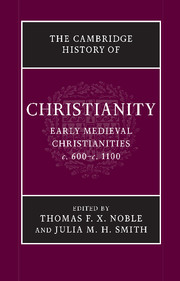Book contents
- Frontmatter
- Introduction: Christendom, c. 600
- Part I Foundations: Peoples, Places, and Traditions
- Part II Christianity in Confrontation
- Part III Christianity in the Social and Political Order
- Part IV Christianity as Lived Experience
- Part V Christianity: Books and Ideas
- 24 Visions of God
- 25 Orthodoxy and deviance
- 26 Making sense of the Bible
- 27 The Christian book in medieval Byzantium
- 28 Saints and their cults
- 29 Last Things
- Conclusion: Christendom, c. 1100
- Bibliographies
- Index
- References
26 - Making sense of the Bible
from Part V - Christianity: Books and Ideas
Published online by Cambridge University Press: 28 March 2010
- Frontmatter
- Introduction: Christendom, c. 600
- Part I Foundations: Peoples, Places, and Traditions
- Part II Christianity in Confrontation
- Part III Christianity in the Social and Political Order
- Part IV Christianity as Lived Experience
- Part V Christianity: Books and Ideas
- 24 Visions of God
- 25 Orthodoxy and deviance
- 26 Making sense of the Bible
- 27 The Christian book in medieval Byzantium
- 28 Saints and their cults
- 29 Last Things
- Conclusion: Christendom, c. 1100
- Bibliographies
- Index
- References
Summary
In his capacity as adviser to Charlemagne, Alcuin (d. 804) thought that he could introduce his master to all the subtleties of rhetoric and moral philosophy. In the famous Dialogue on Rhetoric and the Virtues, Alcuin cast himself in conversation with the future emperor of the Franks. He prudently made sure to show his patron in a good light by having him pose apposite questions to which he, as teacher, replied by playing with all the resources of the classical Latin art of rhetoric that he taught, the better to persuade his royal audience. Where rhetoricians had drawn the examples necessary for their demonstration from pagan antiquity, Alcuin brandished biblical examples. The lesson is clear. The courtier of the Dialogus de rhetorica was not content only to cajole a king who aspired to be a man of letters, but thus proclaimed with gusto the enduring value of classical learning in the Frankish realms, the triumph of Christian letters, and the absolute primacy of the Bible over all other masterpieces of literary history.
Of course, this is only propaganda. It matters little, however, whether this Dialogue was really written for the benefit of Charlemagne or whether it was a fiction created for use exclusively in schools. In just a few lines it upsets commonly accepted notions of an edition of the Bible by Alcuin (our teacher “forgets” to cite his own version of the Book of Genesis!) and of widespread ignorance of the Scriptures outside clerical circles (the mere mention of the characters of Cain and Abel, Achitophel, Chusai, Tertullus, and Felix, although elaborated orally by the teacher, suffices for the audience of the stories).
- Type
- Chapter
- Information
- The Cambridge History of Christianity , pp. 531 - 553Publisher: Cambridge University PressPrint publication year: 2008



